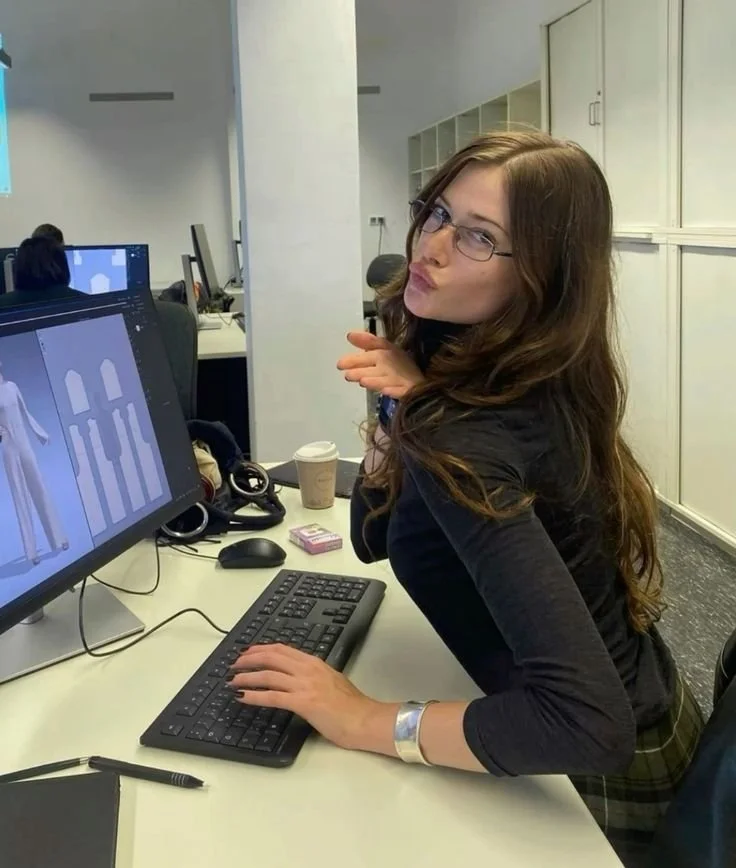Power, Performance, and the Office Siren Fantasy
Credit: Claudia Schiffer by Michel Comte for Vogue Italia, July 1994
Power, Performance, and the Office Siren Fantasy
There’s something undeniably alluring about the “office siren” aesthetic. The sharp lines of a tailored pencil skirt, the satisfying click of a sleek stiletto on tile, the quiet sheen of a neutral silk blouse unbuttoned just so. It’s eye catching. It’s powerful. It’s cinematic. It’s also maybe not the feminist serve we think it is. As an aesthetic that blends elton’s of fantasy with practicality in a uniquely internet friendly way, the “office siren” has lingered since it’s inception.
With the rise of content dressing— looks designed for virality and audience engagement as opposed to practicality, TikTok has revived the 2000s "corporate baddie" trope with a vengeance; glossy lips, tousled hair, Balenciaga city bag in hand, all while pretending to file paperwork no one asked for. And while we collectively heave at Gen X's depiction of "business casual" (read: frumpy oatmeal sweaters and lifeless loafers), swinging the pendulum all the way into hypersexualized cosplay isn’t exactly progress either.
So what’s going on here? Why are we sexualizing the very aesthetic that was once meant to obscure the body in favor of one’s professional identity? Why does arriving at the office dressed like Bella Hadid feel more like drag than daily wear?
Let’s unpack it.
The Office Siren: Capitalism’s Favorite Double Standard
It’s giving Emily from “The Devil Wears Prada” if she had access to a trendy fast-fashion PR package. The “office siren” trend borrows heavily from femme-fatale tropes of decades past: tight waistlines, sharp eye makeup, dark neutrals, dominatrix-adjacent footwear. It’s chic and nostalgic, but undeniably rooted in male fantasy. As media critic John Berger theorizes; “men act and women appear”, implying there are inherently voyeuristic/exhbitionist dynamics between male spectatorship and female subject matter.
This aesthetic walks a very specific line: powerful, but still palatable. Assertive, but only if it’s sexy. It's the Pinterest board version of what power looks like when filtered down through the male gaze: equal parts productivity and provocation.
At its core, the look says: I’m here to work, but I’m also here to be seen.
Credit: @pudderfly
The Aesthetic Labor of Being Taken Seriously (While Still Serving)
Here’s where there becomes a problem: women have always been asked to perform in the workplace. Not just in terms of output, but appearance. Where men get to be brilliant in a wrinkled button-up, women must be competent and polished, chic but not distracting, attractive but not too attractive.
In other words, the unspoken dress code for women is often: try hard, but make it look effortless and God forbid you make someone uncomfortable by being too much of anything. This is a form of aesthetic labour, where physical appearance, style, and presentation, become part of the job, especially for female professionals navigating this space.
Hyper-feminine aesthetics like the office siren are sold to us as empowerment. But when you peel back the layers, what’s underneath is often a performance of desirability masquerading as confidence. And sure, we love a bit of fantasy. But should your morning commute feel like you're walking into a perfume ad?
Sex Doesn’t Equal Style; and in this case, will result in a write up.
The office siren could only ever work in a real life professional setting in theory, and to a certain extent. Ask any woman who has been pulled aside for “looking too confident” in a form fitting pencil skirt.
Most corporate spaces still police women’s bodies with unwritten rules and passive-aggressive stares. That tasteful slit skirt? Too provocative. The fitted cardigan? A distraction. The bold red lip? “A bit much for 9 am” The line between fashion forward and “inappropriate” is razor thin and heavily gendered.
Dress codes are rarely about function. They’re about control. And the hypervisibility that comes with femme aesthetics often gets coded as unprofessional, unserious, or even threatening. The irony? Dressing in “sexy” corporate style can make you less powerful in the spaces where real power is exchanged.
So where’s the middle ground?
Credit: Christy Turlington & Naomi Campbell by Bill King for Vogue Paris, August 1987
Power Dressing Reimagined: Style Without Spectacle
Instead of tossing out the trend completely, maybe it’s time to evolve it.
What if we stripped the male gaze out of the office siren and made room for style that feels both expressive and grounded? Clothes that don’t require you to contort into any hyper feminine archetypes or hide behind shapeless gray slacks either?
The real office siren isn’t about dressing louder – it’s about dressing sharper. About showing up in a way that reflects you, not some editorial fantasy of power. Because what we wear to work shouldn’t feel like drag or disguise. It should feel like clarity. Confidence. A kind of quiet rebellion that doesn’t scream for attention but still refuses to blend in.
Fashion and aesthetic categories Can Be Liberating But It Has to Be Yours
Stay tuned in, as we’ll be diving into that question more deeply in a separate post. A practical, reflective guide to building your personal style across different work settings without falling into the trap of performance. But for now, consider this your permission slip: you don’t have to dress like a fantasy to feel powerful. You just have to dress like yourself.
Let’s retire the idea that power needs to be pretty to be palatable. Or that femininity has to come with a side of spectacle. Because real power dressing? That’s when your outfit speaks before you do and says exactly what you want it to.


